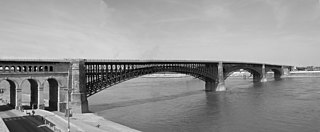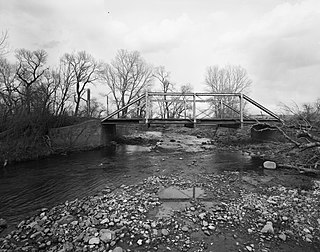Turkey Creek may refer to:
Luten Bridge Company and variations such as Luten Engineering Company was the name of a number of different bridge building companies in the United States during the early- to mid-20th century. Each had rights to build concrete Luten arch bridges, according to the patented designs of Daniel B. Luten, of Indianapolis.
The Nebraska Department of Transportation (NDOT) is the state government agency charged with building and maintaining the state highways in the U.S. state of Nebraska, as well as the state's airports. The main headquarters of the agency is located in Lincoln, the capital city. There are currently eight NDOT district offices located across the state.
The Kansas City Bridge Company was a bridge building company that built many bridges throughout the Midwest United States in the early 1900s. The company was founded in 1893 and ceased business around 1960.

The King Iron Bridge & Manufacturing Company was a late-19th-century bridge building company located in Cleveland, Ohio. It was founded by Zenas King (1818–1892) in 1858 and subsequently managed by his sons, James A. King and Harry W. King and then his grandson, Norman C. King, until the mid-1920s. Many of the bridges built by the company were used during America's expansion west in the late 19th century and early 20th century, and some of these bridges are still standing today.

The Western Bridge and Construction Company, located in Omaha, Nebraska, was one of the foremost bridge engineering and manufacturing companies in the Midwestern United States. Several of their bridges are now listed on the National Register of Historic Places. Their headquarters were located in the Bee Building in Downtown Omaha.

The Keystone Bridge Company, founded in 1865 by Andrew Carnegie, was an American bridge building company. It was one of the 28 companies absorbed into the American Bridge Company in 1900. The company advertised its services for building steel, wrought iron, wooden railway and road bridges. It held a patent for wrought iron bridges and also supplied wrought iron columns for buildings. Thomas Carnegie worked for Keystone Bridge as treasurer for roughly 20 years, from the founding of the company until his death in 1886.

The ECS Bridge over Big Goose Creek was a bridge near Sheridan, Wyoming, that was built in 1914. It was a Pratt pony truss bridge built by the Canton Bridge Company of Canton, Ohio. The Canton Bridge Company built four steel bridges in Wyoming in 1914; when nominated to the National Register of Historic Places in 1982, the ECS Bridge was the only one of these surviving in its original location. It was 50 feet (15 m) long and 15 feet (4.6 m) wide.

The Pueblo Bridge Co. is a firm that built a large number of bridges in the United States. Several are listed on the U.S. National Register of Historic Places.

The Missouri Valley Bridge & Iron Co., also known as Missouri Valley Bridge Company, was a engineering, construction, and steel fabrication firm that operated through the late nineteenth and most of the twentieth centuries. It was based in Leavenworth, Kansas, with a WWII facility in Evansville, Indiana.

The Midland Bridge Company is a firm based in Kansas City, Missouri, United States, that has built numerous bridges. Several of its works are listed on the U.S. National Register of Historic Places (NRHP).
Standard Bridge Company was an American bridge company that was "one of the most important bridge building firms in Nebraska history."

George Herndon Pegram (1855–1937), most commonly known as George H. Pegram, was an engineer who patented the Pegram truss.

Monarch Engineering Co. was an American firm of Denver, Colorado, active in engineering and construction services. John A. Crook and his brother, Guy A. Crook of Falls City, were founders of the Monarch Engineering company which had its origin and main offices at Falls City, with offices in Kansas City, and Denver. Under the management of these men the Monarch Engineering company had risen to become an important and prosperous concern and a vast amount of bridge construction, city paving, irrigation-dam building, and public building work has been done under their supervision. Within ten years after the firm had been in operation, or since 1908, its activities constantly increased and in 1917 they purchased the Denver Steel and Iron Works in order to facilitate the material supply part of the construction work in which they were engaged.

The Illinois Steel Company was an American steel producer with five plants in Illinois and Wisconsin. Founded through a consolidation in 1889, Illinois Steel grew to become the largest steel producer in the United States. In 1898, several other steel and transportation companies were merged into it to form the Federal Steel Company, itself merged into U.S. Steel in 1901.

The Bell Bridge, crossing the Niobrara River near Valentine, Nebraska, is a historic bridge that is listed on the National Register of Historic Places.

The Brewer Bridge, near Valentine, Nebraska is a historic Pratt through truss bridge that was built in 1899. It was designed by the Wrought Iron Bridge Co. of Canton, Ohio, was fabricated by the Jones & Laughlin Steel Co., and was built by the Wrought Iron Bridge Co. Also known as the Niobrara River Bridge and denoted NEHBS No. CE00-226, it was listed on the National Register of Historic Places in 1992.

The Graneros Shale is a geologic formation in the United States identified in the Great Plains as well as New Mexico that dates to the Cenomanian Age of the Cretaceous Period. It is defined as the finely sandy argillaceous or clayey near-shore/marginal-marine shale that lies above the older, non-marine Dakota sand and mud, but below the younger, chalky open-marine shale of the Greenhorn. This definition was made in Colorado by G. K. Gilbert and has been adopted in other states that use Gilbert's division of the Benton's shales into Carlile, Greenhorn, and Graneros. These states include Kansas, Texas, Oklahoma, Nebraska, and New Mexico as well as corners of Minnesota and Iowa. North Dakota, South Dakota, Wyoming, and Montana have somewhat different usages — in particular, north and west of the Black Hills, the same rock and fossil layer is named Belle Fourche Shale.
The Milwaukee Bridge & Iron Works, also known as the Milwaukee Bridge Co. and as Milwaukee Bridge & Iron Co., was a firm based in Milwaukee, Wisconsin.
The Stonelake Bridge, on Winkler Rd. about 4 miles (6.4 km) west of Newell, in Butte County, South Dakota, was listed on the National Register of Historic Places in 1986. It was manufactured in 1910. Also known as the Horse Creek Bridge, it is a pony truss lattice bridge built by the Canton Bridge Co. The bridge was moved in 1972.















